Wine is a complex beverage with a lot of characteristics to experience. Especially old wines have many different aromas to offer. But to release them and allow you to enjoy them to the fullest, they need a helper: oxygen. Enter the wine decanter.
A wine decanter is a glass bottle that has the purpose of exposing the wine to oxygen and enhancing its flavors. Besides, it helps separate the sediment that wine might contain from the liquid, so it does not harm the drinking experience.
So if you care about what your wine tastes like, you should think about getting a decanter. And if you want to learn how a decanter works, simply keep reading.
WHAT DOES DECANTING MEAN?
Decanting is a term that originates from chemistry. It describes the process of pouring a liquid from one container into another while leaving solid parts behind. In the context of wine, the solids are called sediment. These small particles typically are remains of grape solids, such as seeds, stems, or skins. By pouring the wine into a decanter and leaving the sediment in the bottle, you filter it.
Additionally, you aerate the wine. Or in other words, you get the wine in touch with oxygen that helps it to “open up”. That allows the wine to release all of its aromas and show its full complexity.
Sometimes wine lovers even double-decant their wines to maximize the effect.
WHAT IS THE PURPOSE OF DECANTING WINE?
Decanting wine has three main purposes:
You can definitely enjoy wine without decanting it, and most wine lovers do so. But using a decanter can improve your wine experience so you enjoy it even more.
Removing Sediment from the Wine
Red wines do get better with age. But they also tend to gather more sediment during the aging process. Sediment consists of small grape parts that winemakers do not filter out before bottling the wine. They might also come from ingredients they add during the winemaking process. As the wine ages, the solids slowly begin to separate from the liquid.
The sediment does not have an overall effect on the taste of the wine. But it can impact the mouthfeel if you catch some as you sip. Not to mention, the idea of unknown solids making their way into your mouth does not sound great.
Using a decanter and letting the wine sit will make the solids settle to the bottom of the bottle. When you pour the wine into the decanter, they stay inside the bottle (given that you do it right). So decanting will prevent the sediment from finding its way into your glass and your mouth.
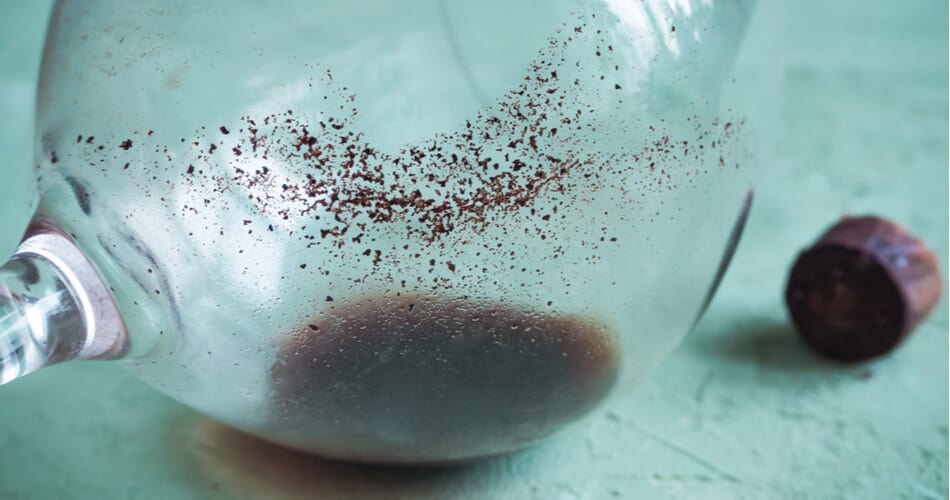
Enhancing the Flavors
The second reason for decanting wine might be even more important than the first one because it affects more types of wines. Sediment is a more common problem with older wines. But oxygen flow is an issue that affects both the young and old. Especially wines that did not age in oak tend to be a little tight because their flavors have not been able to develop to their full potential.
By decanting these wines, you allow them to breathe. They get in touch with oxygen, and this oxygen starts chemical reactions. As a result, the flavors open up, so you can enjoy them to the fullest.
Wines that are high in tannins can also benefit from exposure to oxygen. Tannins produce the mouth-drying sensation that many wine enthusiasts love. But in some cases, they are so strong that they overpower the wine’s flavors. By decanting these wines, you give the tannins a chance to soften slightly, so the overall balance is more pleasant.
Filtering Cork Particles Out
It can happen to even the most experienced wine drinkers: While opening the wine, the cork breaks, and pieces of it fall into the wine. These pieces can do serious harm to your wine. A wine that is “corked” because the cork imposed unpleasant aromas on it is ruined. There is no way to repair this fault.
So when this happens, you must get the cork pieces out of the wine immediately. Using a decanter will help your cause. Like allowing sediment to sink to the bottom, pieces of cork will also separate from the wine itself. However, cork pieces will usually float, and it takes much longer until they sink to the ground. When they finally do, the wine might be too warm or over-aerated.
If you are decanting to avoid cork bits, pouring the wine slowly into the decanter is the best route to take so that pieces of cork will remain in the bottle. To catch even the smallest parts, it is a good idea to use a coffee filter in addition.
THE ALTERNATIVE TO DECANTING: SWIRLING WINE IN YOUR GLASS
Decanting wine is not exactly controversial, but some folks believe it is not necessary. So, to get the full picture, let us talk about the alternative: Swirling wine in your glass before you drink it.
Swirling basically does the same as decanting, at least in terms of aeration. By moving the wine in your glass, you let oxygen get in touch with it and do its job.
For many light wines, this process might actually be a sufficient alternative to decanting. However, some wines need more time in contact with air than just a couple of seconds. And you probably do not want to swirl your wine around for half an hour. So for full-bodied wines, a decanter still is the better solution.
Also, swirling will not help you get unwanted particles out of the wine. So if your wine has sediment or cork pieces in it, there is no way around decanting.
WHICH WINES NEED TO BE DECANTED?
There are three groups of wines that need decanting:
- Full-bodied red wines
- Full-bodied white wines that underwent oak aging
- Old wines of all kinds
Determining which wines exactly need decanting and which wines do not might be a little bit intimidating. But actually, it is not that hard. And you cannot make a serious mistake because even wines that do not get better during decanting will usually not worsen either.
To find out whether a wine needs to be decanted, ask yourself these questions:
What Kind of Wine Is It?
A general rule is that reds can benefit the most from decanting. But using a chilled decanter for a Rosé or certain whites can enhance the flavors too. That is especially true for less expensive wines. Allowing them to breathe during decanting can help release their hidden aromas. Heavier whites, like oaked Chardonnay, should definitely undergo a quick decanting.
Is Your Wine Fruity?
If your wine has fruity flavors, in particular red fruits, it is typically a lighter-bodied wine. Therefore, decanting is not necessary. If you do choose to decant, a short time in a chilled decanter will do the trick. These are common red fruits notes you can sense in these light wines:
- Raspberries
- Cranberries
- Strawberries
- Cherries
On the other hand, a wine that offers notes of black fruits is typically full-bodied. These wines should be decanted. Here are dark fruit aromas that you can find in full-bodied wines:
- Plums
- Blueberries
- Black Currant
- Blackberries
How Old Is the Wine?
If you are about to crack open an older bottle of wine that has been aging for quite some time, you should definitely use a decanter. It likely has sediment in it that has been released over time. Decanting will help to get this sediment out of the wine, so it is a must-do.
But there is a thin margin of error when decanting older wines. Some of them should not be left out for too long because overexposure to oxygen will negatively impact their delicate flavors.
WHAT DOES A DECANTER LOOK LIKE?
Decanters look like beer pitchers or water carafes – with a strange shape. You can find various designs that are supposed to serve different types of wine by optimizing oxygen flow.
These are the most common types:
Standard Decanter
The trusty standard decanter is the most common type. It has a large, usually rounded and wide base and a long, thin neck. Since the standard design is so adaptable, it works basically with any type of wine. However, the actual size of the decanter’s base dictates the exact wines that will work best. We will discuss more details on that later.
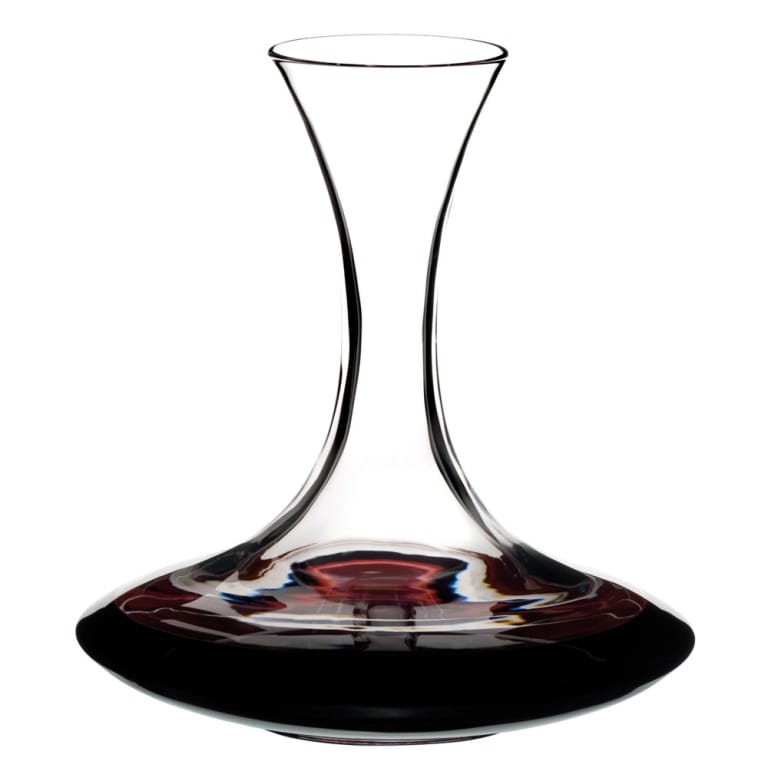
$199.97
from: Wine.com
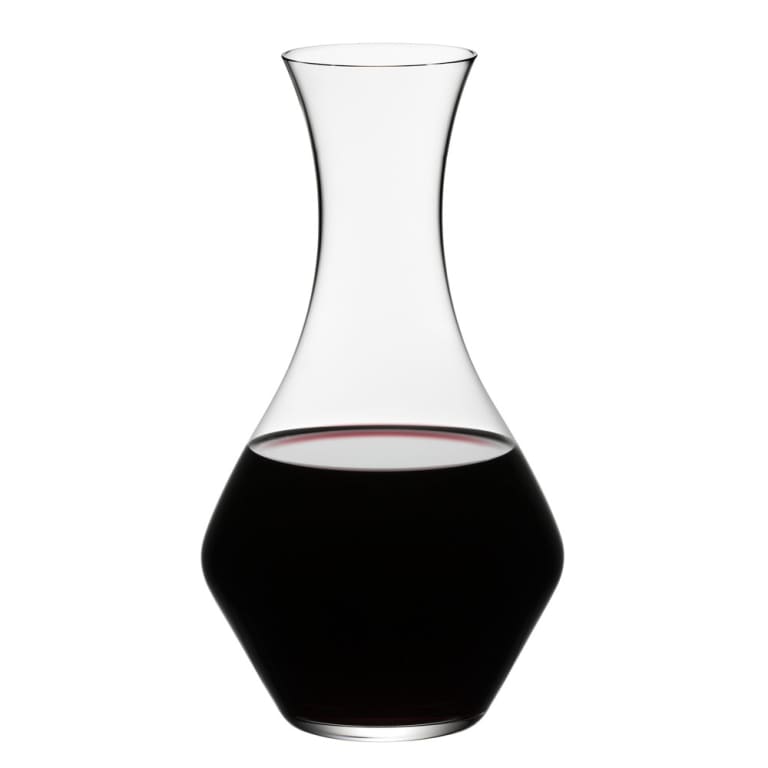
$69.97
from: Wine.com
Cornetto Decanter
A Cornetto decanter has a smaller base than a standard decanter and a slightly longer neck. It might remind you of a water carafe rather than a decanter at first glance. The design is versatile and can be adjusted to work with a variety of wines. But, generally speaking, a Cornetto decanter is best used for medium-bodied wines.
Swan Decanter (U-Shaped Decanter)
The swan decanter has a U-shape with two long upward-pointing extensions. Both are open and let air get inside the decanter.
One of them has a rather big opening. That is where you fill in the wine. The other, smaller opening is the end where the wine should be poured from (see the image in the “How to Use a Wine Decanter” section below).
This design lets less air in than the standard decanter, and it also has a smaller base. With this medium-sized base, the swan decanter is the best pick for light- to medium-bodied wines.
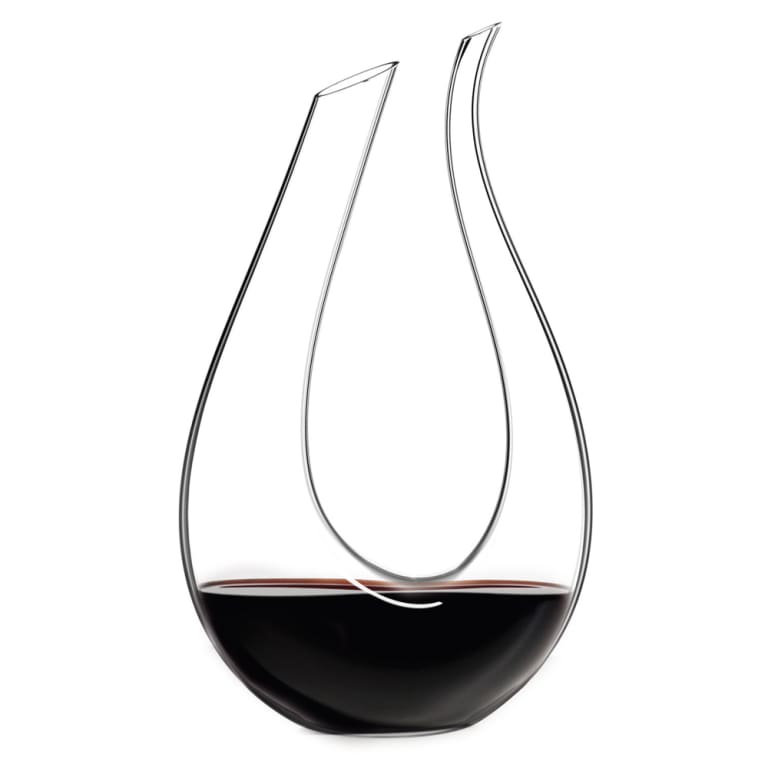
$524.97
from: Wine.com

$424.97
from: Wine.com
Duck Decanter
The duck decanter is by far the most complex-looking of the decanters. And it really looks like a duck.
It has a small to medium base and a tiny neck that lets only a bit of air in. Thus, it reduces the oxidation rate significantly.
The duck decanter works best with wines that require only a bit of aeration. That is true for most white wines as well as rosé wines.
But some red wines with a light body belong to this category as well. For decanting all of these wines, the duck decanter is the right choice.
WHY IS THE DECANTER SIZE IMPORTANT?
The size of a decanter is a crucial factor because it determines how much oxygen gets to the wine. The bigger it is, the more air will interact with the wine and the faster it will aerate.
Small-Based Decanter
A decanter with a small base does not allow as much oxygen flow, so it is best used for wines that do not require a lot of aeration. Light-bodied wines, especially fresh white and rosé wines, require this type of small-based decanter. Wines made from these varietals belong to this category:
- Pinot Noir
- Grenache
- Blaufränkisch
- Beaujolais
- Gamay
- Lambrusco
- Beaujolais
- Riesling
- Sauvignon Blanc (unoaked)
Medium-Based Decanter
A decanter with a medium base is the best choice to decant medium-bodied wines. Among others, these medium-bodied wines benefit from a medium-based decanter:
Wide-Based Decanter
Full-bodied wines are the ones that need the longest decanting and the most aeration. A decanter with a wide base is your best bet to optimize the flavors of these wines:
- Mourvèdre
- Malbec
- Cabernet Sauvignon
- Syrah/Shiraz
- Durif/Petite Sirah
- Petite Verdot
- Pinotage
- Zinfandel
- Chardonnay (oaked)
- Sauvignon Blanc (oaked)
HOW LONG SHOULD YOU DECANT WINE?
Typically, light-bodied red wines, most white wines, and rosé wines should not spend more than 30 minutes in a decanter. Again, in many cases, decanting is not necessary at all. Full-bodied whites and reds can take a little more oxygen. Depending on the varietal, you can decant them for up to 3 hours.
In sporadic cases, you might have to decant a wine for even longer. Very old wines can develop “bottle sickness“, a condition where fruity flavors are completely muted. Especially Madeira, Port, or similar fortified wines can suffer from it. To give them a chance to open up again, they need more time in the decanter. It might take up to 24 hours until the bottle sickness disappears, and you can enjoy their full bouquet.
Be aware that too much aeration can be a problem. If you expose your wine to air for too long, its pleasant flavors can dissolve and leave the wine flat and dull. So the right amount of oxygen (or the right time of exposure to oxygen) is key.
Here are some guidelines for specific wines and how long to decant them:
| WINE | DECANTING TIME |
| Pinot Noir | 30 minutes |
| Primitivo | 1 hour |
| Sauvignon Blanc | 1 hour |
| Chardonnay | 1 hour |
| Grenache | 1 hour |
| Malbec | 2 hours |
| Cabernet Sauvignon | 2 hours |
| Merlot | 2 hours |
| Petite Sirah | 2 hours |
| Sangiovese | 2 hours |
| Chianti | 2 hours |
| Tempranillo | 2 hours |
| Syrah/Shiraz | 2 hours |
| Vintage Port | 2 hours |
| Mourvèdre | 2.5 hours |
| Dão | 3 hours |
| Madeira | 3 hours |
| Nebbiolo | 3 hours |
| Barolo | 3.5 hours |
If you want to fine-tune your decanting times, try some experimenting on your own. Buy multiple bottles of the same wine and try decanting them for different periods of time. By comparing the drinking experiences, you will be able to determine the proper decanting time more precisely. Since everyone’s taste buds and palates are different, that is a really good way to make sure that your wine matches your personal preferences.
HOW TO USE A WINE DECANTER
Using a wine decanter to aerate a wine consists of five steps:
- Prepare the wine bottle by leaving it standing upright for 24 hours.
- Open and clean the outside of the bottle.
- Check for sediments.
- Pour the wine into the decanter until the bottle is almost empty.
- Let the wine rest.
To make sure you do it correctly, let us discuss the specifics of each step in more detail:
Prepare Your Wine Bottle
Most wines are best stored lying on their side. As soon as you take it out off the shelf, the sediment will swirl up and disperse in the wine. Thus, you should allow the bottle to stand upright for at least 24 hours before decanting it. During this time, all tiny particles will make their way to the bottom of the bottle. That will make it much easier to pour the wine into the decanter while leaving the sediment in the bottle.
Open and Clean Your Wine Bottle
Remove the cork or the top of your wine bottle. Use a dry, soft cloth to remove any dust or other residue that could get into the wine during pouring. Wipe the top of the bottle, and also clean the rim of the decanter.
Check the Sediment
To check whether and how much sediment is in the bottle, use a light. Natural light from a window or a flashlight will do the job. Hold the bottle in front of the light to determine what kind of sediment you are dealing with. It might be hard to see the particles, but any darker color or cloudiness toward the bottom of the bottle is usually evidence of such.
Be mindful: Do not shake the bottle too much during this process, or you will swirl up the sediment and mix it back into the wine accidentally.
Pour the Wine into the Decanter Slowly
A slow, continuous pour is essential here. Gently tipping the bottle toward the decanter will make for an easy and smooth pour. Keep an eye on the amount of wine left in the bottle.
Stop When the Bottle Is Almost Empty
Once you have poured out most of the contents and have about a quarter of the bottle left, ease up on the pouring. It is okay to leave some wine in the bottle. In fact, it is probably best to just plan on doing that.
Since sediment does not always show up in solid form, you should be wary of any coloring that is off. It is a good signal that it is time to stop pouring. Also, if you see any evidence of sediment in the neck of the decanter, stop immediately.
Let the Wine Rest
Allow the wine to sit in the decanter as long as the guide above suggests. If your exact wine is not on the list, follow the time frame for a similar bottle and shorten it by five to ten minutes. Underexposure is better than overexposure. And if you feel like it needs slightly more aeration after the wine is in your glass, give it a couple of swirls for more oxygen. Now it is ready to drink!
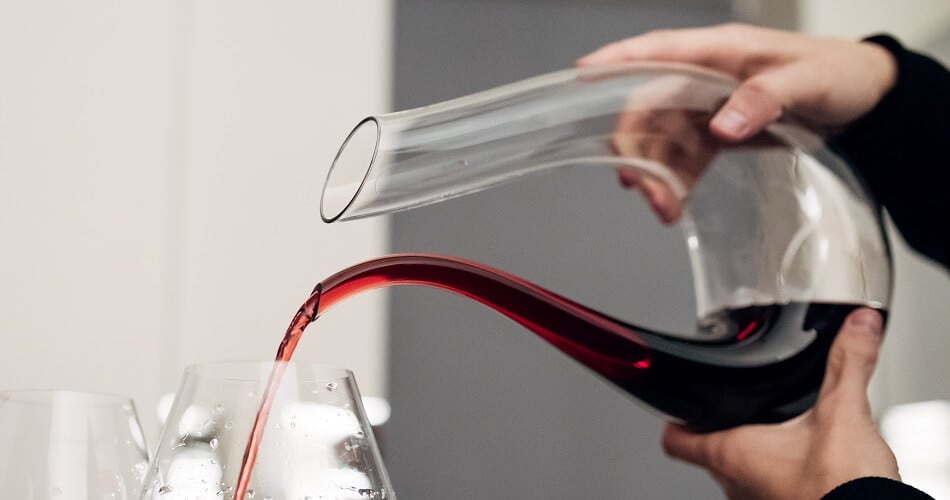
WINE DECANTER SHOPPING TIPS
When shopping for glassware, you will realize that there is a fair variety of decanters available. To find the right one for you, take the following tips into account.
Decanter Material: Glass vs. Crystal
Most decanters, especially those that are in the affordable price range, are made from glass. But, some of the more expensive decanters are made from crystal glass. The more expensive crystal decanters do not necessarily work better, and they are typically more breakable. Also, some wine lovers say that the lead used to produce crystal glass negatively affects the taste of wine. So there is no shame in owning a regular glass model.
Functionality vs. Aesthetics
There are plenty of high-end wine decanters out there that are ornate in design and made to impress. That does not equal quality, though. Some of the more extravagant designs do not pay off in functionality. A simple model is usually your best bet unless you are looking for added curb appeal.
Hand-Made vs. Mass-Produced
Wine decanters that are mass-produced are likely to be less expensive than those that are handmade. Glass blowing is an incredible art form, and there are plenty of wine decanters with spacy designs. These will not necessarily work better, although they come with a bigger price tag. But they are better eye-catchers for sure.
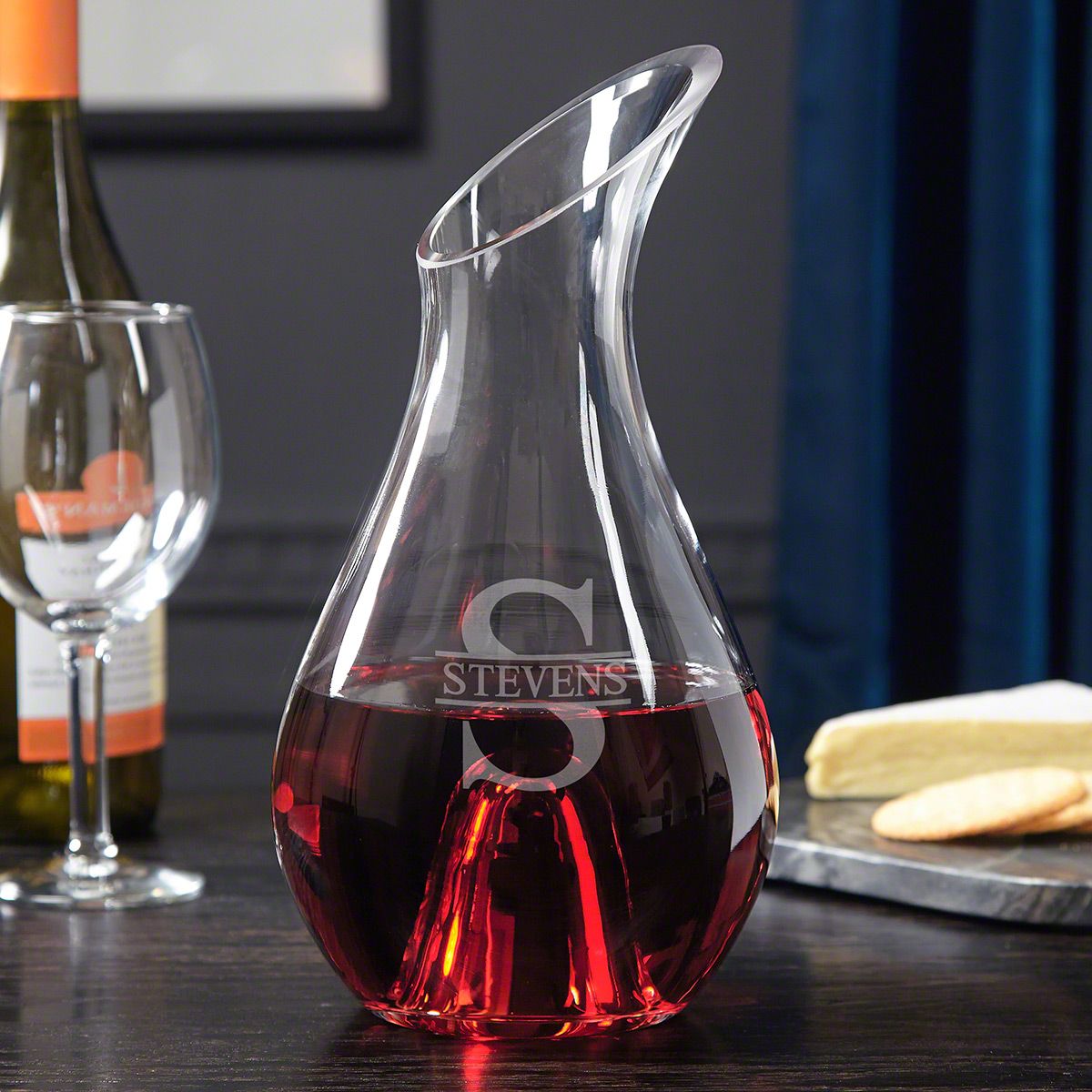
$69.95
from: HomeWetBar.com
Decanter Prices
Wine decanters vary in price quite a bit, as you will notice when shopping around. There are more affordable options that start at around 50 USD. On the other end of the spectrum, decanters from the most prestigious manufacturers cost upwards of 400 USD. For a good wine decanter, you should expect to spend between 100 and 200 USD on average.
Personalization
Some manufacturers allow you to personalize decanters by engraving them. These personalized decanters are great gifts for wine lovers.
FINAL WORDS
A wine decanter is a fantastic tool to have on hand. If you are a true wine lover and enjoy a glass on a regular basis, a decanter is something you should absolutely invest in. It does not have to be a major investment; a simple decanter will do. But having it waiting in the wings in case you need one definitely is a good idea.
Recent Posts
Switzerland is famous not only for its beautiful landscapes and its picturesque towns but also for some food items. Especially Swiss cheese and chocolate are world-famous. But do you actually know a...
Winemaking is a sophisticated process that includes multiple steps and can take several years. Depending on the desired wine and the vintner's preferred techniques, these steps can differ. However,...

